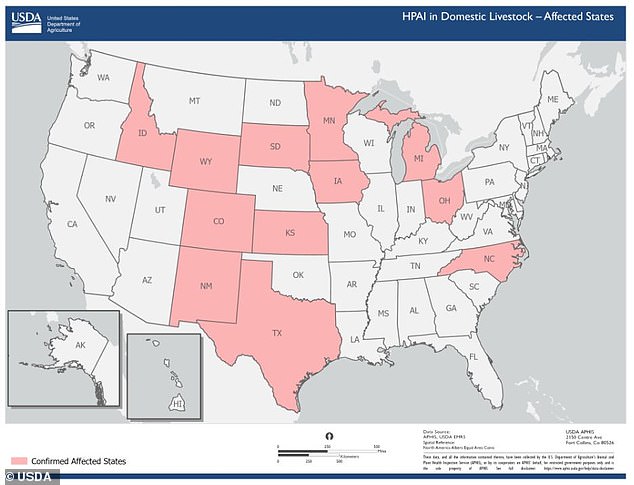A top doctor warned that the USDA and CDC are “blind” to a possible national bird flu outbreak in the United States due to a lack of testing.
Dr. Rick Bright, a virologist and former director of the Department of Health and Human Services, said the level of concern is higher than it appears on the surface, as only three Americans have tested positive for the virus.
He warned that despite the low number of cases, it is possible that the virus is mutating, allowing it to better infect humans.
In an interview with PBSHe said: ‘Right now I’m more concerned about the information and data we’re missing.
“We’re blindfolded in this battle right now, and I’m really worried that the virus is winning the game and getting ahead of us.”
Dr. Rick Bright, in an appearance on PBS, warned of the dangers of the bird flu pandemic in the US.
Scientists They say the risk is high because of widespread infections in cattle, whose udders contain receptors found in the lungs of both birds and humans.
To date, the CDC has only tested 45 humans for bird flu, which the agency says it only does when there is concern that the person may be infected.
But with so many herds infected with the virus (102 as of yesterday) there are fears that the virus may be acquiring new mutations.
Dr. Bright added during the interview: “When I talk about we’re not doing enough about this, it’s because we really don’t know how many humans have been infected with this virus.”
‘And, today, very limited or almost no serological testing has been carried out among the cases, their close contacts on the farm or their family members.

The map above shows states where avian flu infections in livestock have been reported.
“So it’s really difficult for us to know how many people have been exposed and whether there really is person-to-person transmission or not.”
Genetic testing by the CDC has shown more than 300 mutations of the virus in cattle, including some that can make the virus more infectious.
Three Americans tested positive for bird flu this year, including one who had respiratory symptoms and two who suffered from eye infections.
Experts fear others may have been infected, but cases may have been missed because patients did not come forward.
Many farms have not cooperated with officials, reports suggest, likely because of concerns that livestock will be slaughtered or because they are using undocumented workers.
There have also been problems testing herds to establish which animals are infected.
Many infectious disease experts have expressed concern about the lack of testing, saying it leaves them unsure whether cases among livestock are still rising or may be peaking.
Dr. Leonard Mermel, an infectious disease expert at Brown University, warned in his local newspaper this week: “Our federal government does not have the authority to test farm animals for the H5N1 virus, nor to require H5N1 testing of people exposed to infected cows, or to prevent (the sale of) raw, unpasteurized milk… until the infection among the cows has been controlled.
“So the H5N1 virus is among us, where millions of viral particles are found in the udders of many cows in the US, infecting their tissues that contain human influenza receptors, facilitating the possibility of the virus jumping from cows to humans.”
Yesterday, a former CDC director warned that the United States would eventually face another bird flu pandemic.
Dr. Robert Redfield, who led the agency from 2018 to 2021, said in an interview: “I really think it’s very likely that at some point we will have it; it’s not a question of if, but rather when, we will have a Pandemic. of bird flu.’
Previous data shows that 52 percent of people who have suffered a bird flu infection have died from the disease.
By comparison, in the early days of Covid this figure was closer to ten percent of patients.
‘Once the virus acquires the ability to attach to the human receptor and then move from human to human, that is when the pandemic occurs.
“And, like I said, I think it’s just a matter of time.”
In the first two cases of bird flu recorded in the US this year, the patients only had ocular symptoms.
But in the third case, the patient had respiratory symptoms, suggesting the virus may have infected his lungs.
Authorities reported that there were no signs of virus transmission, although they have had problems accessing the homes of the cases.

